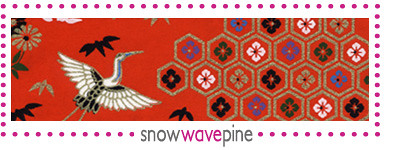
Even before I started designing invitations for a living, I always had an obsession with paper. So, being able to shop for papers with unusual textures or patterns is probably the most fun I've ever had at any job...that's no exaggeration! Since I often work with imported yuzen washi from Japan, I was inspired to learn more about the the meanings behind some of the more traditional patterns found on the beautiful handmade papers.
The photo above is from a swatch of paper that I'm using for a client's table cards this week. It's also the same paper that was used on their wedding invitations. Inspired by the obi from the bride's custom wedding gown, I searched for a paper with vibrant red and orange colors, and one that was also full of rich symbolism. The crane (or tsuru) has traditionally been considered a sign of lonvevity and good luck, as has the hexagonal tortoise shell pattern seen on the right edge of the paper. The hexagon pattern was originally a Chinese motif, but was adopted by the Japanese during the Heian period. Because of its refined design and connotations of longevity, the pattern was often used for regal court dress, and later for warriors' kimonos and armor.
For a quick introduction to Japanese design motifs, Snow, Wave, Pine by Sadao Hibi and Motoji Niwa is an excellent (and beautiful) book! So the next time you see a pretty washi paper, take a closer look. You might be surprised what you find!
The photo above is from a swatch of paper that I'm using for a client's table cards this week. It's also the same paper that was used on their wedding invitations. Inspired by the obi from the bride's custom wedding gown, I searched for a paper with vibrant red and orange colors, and one that was also full of rich symbolism. The crane (or tsuru) has traditionally been considered a sign of lonvevity and good luck, as has the hexagonal tortoise shell pattern seen on the right edge of the paper. The hexagon pattern was originally a Chinese motif, but was adopted by the Japanese during the Heian period. Because of its refined design and connotations of longevity, the pattern was often used for regal court dress, and later for warriors' kimonos and armor.
For a quick introduction to Japanese design motifs, Snow, Wave, Pine by Sadao Hibi and Motoji Niwa is an excellent (and beautiful) book! So the next time you see a pretty washi paper, take a closer look. You might be surprised what you find!
